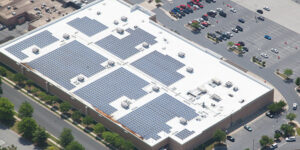Placing solar arrays in urban areas would help Maryland reach its renewable portfolio standard while conserving productive farmland, according to a report issued Tuesday.
The report, released by Chesapeake Conservancy’s Conservation Innovation Center (CIC), lays out large-scale opportunities for solar placement on degraded land and underutilized industrial sites; the rooftops of commercial, industrial and residential buildings; and parking lots. It used geospatial analysis to identify optimal solar sites and determine if there are enough optimal sites for Maryland to reach its solar energy goals.
The Maryland Governor’s Task Force on Renewable Energy Development and Siting estimates that the land needed to meet the state’s RPS will require between 7,000 and 35,000 acres of land across the state.
“This report is a timely reminder we can make real progress on our greenhouse gas reduction and environmental protection goals for a win-win with smart solar siting policies,” said Ben Grumbles, Maryland environment secretary and chair of the state’s Climate Change Commission. “We can expand our state’s homegrown clean and renewable energy supplies by utilizing rooftops, brownfields and waste sites, while avoiding prime farmland and ecologically sensitive lands and forests.”
Maryland is one of 30 states with an RPS to increase electricity production from renewable sources. The state’s mandate currently requires 50% of electricity sold by utilities to come from renewable sources by 2030, with 14.5% from solar in the Clean Energy Jobs Act of 2019 (SB 516).
To meet this goal, the CIC estimates the state will need six times the current solar energy production as siting becomes more difficult as the amount increases. The projects can include everything from small rooftop to utility-scale systems.
Susan Minnemeyer, vice president of technology for the CIC, said the analysis sought to identify enough opportunity sites to produce Baltimore County and Baltimore City’s share of the state’s solar goal. Minnemeyer said based on energy consumption, that share is 1,967 GWh/year of electricity, or about 18% of the statewide goal of 9,000 GWh/year from solar.
Through the analysis, Minnemeyer said that more than enough optimal sites were identified in the Baltimore region: 22,789 GWh/year. She said only 8.6% of the optimal sites identified would need to prove viable to meet the region’s share of solar energy needs.
“Our analysis demonstrates significant opportunities to scale up solar energy development through optimal siting in Baltimore county and city, making use of rooftops, parking canopies and degraded lands to grow Maryland’s solar electricity generation,” Minnemeyer said. “Providing incentives for solar energy development on optimal sites may be one of the best ways to minimize the amount of land needed for solar and avoid potential adverse impacts of development.”
Teresa Moore, executive director of the Valleys Planning Council, who commissioned the study, said her organization supports renewable energy efforts but has been concerned that a lack of siting regulations would lead to farmland being the main target for large-scale solar projects. Moore said almost all the applications in Baltimore County for the first three years of the community solar pilot program have been focused on farmland and not on optimal sites in urban settings.
Moore said her organization would like to see Maryland follow the example of a state like New Jersey that has mapped out optimal solar sites and created a ranking system.
“This helps achieve other goals included in Maryland’s solar legislation calling for job creation and benefits to low- and moderate-income residents, in addition to avoiding conflicts with long-established programs and policies to protect our best farm and forest lands,” Moore said.





